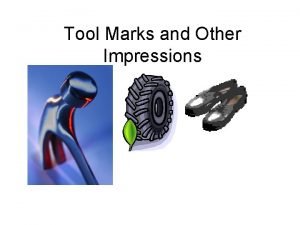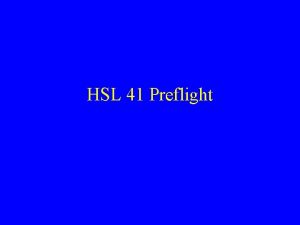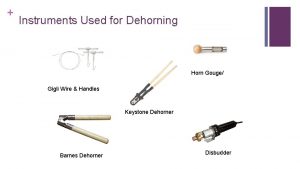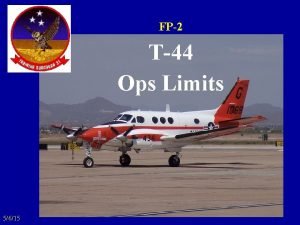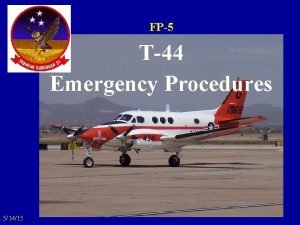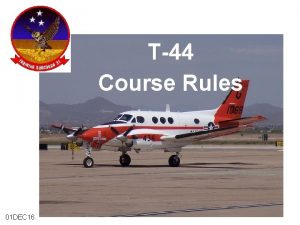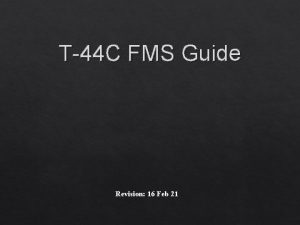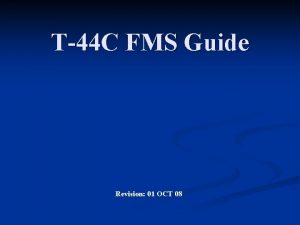T44 A NASCC VT31 GOUGE T44 A V






































































































- Slides: 102

T-44 A NASCC VT-31 GOUGE

T-44 A V SPEEDS

Airspeed Limitations Condition V Airspeed (KIAS) Max dive/level flight VMO 227 Min safe one engine inoperative VSSE 91 Minimum controllable VMCA 86 Maneuvering VA 153 Max gear extended VLE 155 Max gear retraction VLR 145 Max 35% (Approach) Flaps VFE 174 Max Full Flaps VFE 140

T-44 A Vmca Minimum controllable airspeed 86 KIAS

T-44 A

T-44 A Vmcg Minimum controllable groundspeed 63 KIAS

T-44 A VSSE Minimum safe 1 engine inop 91 KIAS

T-44 A VX / VXSE Best angle of Climb 102 KIAS

T-44 A VY 108 KIAS

T-44 A VYSE 110 KIAS

T-44 A VFE Max flap extension/extended (full) 140 KIAS

T-44 A VFE Max flap extension/extended (appr) 174 KIAS

T-44 A VLR Max landing gear retraction 145 KIAS

T-44 A VLE Max landing gear extension 155 KIAS

T-44 A Max endurance glide 102 KIAS

T-44 A Max range glide 130 KIAS

T-44 A VA Maneuvering speed 153 KIAS

T-44 A VMO/VNE Max dive/level flight 227 KIAS

T-44 A ELECTRICAL SYSTEM

T-44 A DC generator voltage 28. 25±. 8 V

T-44 A AC inverter voltage 114± 7/26 V

T-44 A AC inverter frequency 400± 6 Hz

T-44 A Min volts for APU charge 18 V

T-44 A Min volts for APU start 20 V

T-44 A Min battery voltage for Batt start 22 V

T-44 A Starter cycle limits (40 sec, 1 min) x 2, then 30 min

T-44 A Interstage Turbine Temperature (ITT)

T-44 A ITT Normal operating range 400 – 790 °C

T-44 A ITT Max allowable 790 °C

T-44 A ITT Max continuous 790 °C

T-44 A ITT Max reverse 790 °C

T-44 A ITT Max acceleration (up to 2 sec) 850 °C

T-44 A ITT Max low idle 685 °C

T-44 A ITT Max cruising 740 °C

T-44 A ITT Cruise climb 765 °C

T-44 A ITT Max start 925 °C cutoff 1090 °C (2 sec)

T-44 A Torque

T-44 A Torque Normal operating range 400 – 1315 ft-lb

T-44 A Max Torque @ 1900 RPM 1520 ft-lb

T-44 A Max Torque @ 2200 RPM 1315 ft-lb

T-44 A Torque Max acceleration 2100 ft-lb (2 sec)

T-44 A Turbine tachometer (N 1)

T-44 A N 1 Normal operating range 50% – 101. 5%

T-44 A N 1 Low idle range 50% - 53%

T-44 A N 1 High Idle Range 64% - 67%

T-44 A N 1 Max reverse 86%

T-44 A N 1 Max acceleration (2 sec) 102. 6%

T-44 A N 1 Max continuous 101. 5%

T-44 A Propeller tachometer (N 2)

T-44 A N 2 Normal operating range 1800 – 2200 RPM

T-44 A N 2 Max reverse 2100 RPM

T-44 A Max N 2 during accel (2 sec) 2420 RPM

T-44 A Oil Temperature

T-44 A Normal oil temp operating range 10 – 99 °C

T-44 A Max oil temp 99 °C

T-44 A Oil Pressure

T-44 A Normal oil press operating range @ 72% N 1 85 – 100 psi

T-44 A Max oil pressure 100 psi

T-44 A Min oil pressure 40 psi

T-44 A Prohibited maneuvers 1. Intentional Spins 2. Aerobatics

T-44 A General

T-44 A Max ramp weight 9, 710 lbs

T-44 A Max takeoff weight 9, 650 lbs

T-44 A Max landing weight 9, 168 lbs

T-44 A Pneumatic pressure norm operating range 16 ± 4 psi

T-44 A Aircraft ceiling 31, 000 ft

T-44 A Max sink rate on landing 600 FPM

T-44 A Min O 2 required during local/XC flight 1, 000/1, 500 psi

T-44 A Blade angle for beta 15/-5 deg

T-44 A Blade angle for reverse -5/-11 deg

T-44 A Blade angle in feather 87 deg

T-44 A Prop deicer ammeter normal operation 14 - 18 amp

T-44 A Max crosswind 20 kts

T-44 A Max cabin pressure differential 4. 7 psid

T-44 A Gyro suction norm operating range 5. 1 ±. 8 Hg

T-44 A Nosewheel travel left/right of center 12 L/14 R deg

T-44 A Nosewheel travel with brake assist 48 deg

T-44 A Left squat switch (HHHAP) H – AOA Heat H – Heat left engine lip boot H – Electric heat from GRD MAX - normal A – Ambient air solenoid opens w/ airborne P – Pressurization controls 1. Preset, 2. Dump, 3. Door

T-44 A Right squat switch (GFISH) G – Landing Gear circuit inop, downlock hook F – Flight hour meter I – AOA Indexer lights S – Deactivates Stall warning H – Heat right engine lip boot

T-44 A Memory Items (Boldface)

T-44 A Fuel Leak 1) † Condition Lever – Fuel Cutoff 2) Emergency Shutdown Checklist - Execute

T-44 A Engine Failure After Takeoff 1) Power – As Required 2) Gear – UP 3) Airspeed – As Required (VXSE or VYSE) 4) Emergency Shutdown Checklist – Execute

T-44 A Emergency Engine Shutdown on Deck 1) Condition levers – FUEL CUTOFF 2) Firewall valves – CLOSED 3) Boost pumps – OFF 4) Fire extinguisher – As Required 5) Gang bar – OFF 6) Evacuate aircraft

T-44 A Generator Failure 1) Generator-OFF, Reset Momentarily, Then ON. If generator will not reset: 2) Generator – OFF 3) Current Limiter (Battery Ammeter) – Checked

T-44 A Brake Fire 1) Firefighting assistance – Request 2) Stop aircraft 3) Emergency Shutdown on Deck Checklist - Execute

T-44 A Jammed Power Lever † 1) Condition Lever – Fuel Cutoff 2) Emergency Shutdown Checklist - Execute

T-44 A Windmilling Airstart 1) † Power Lever (failed engine) – Idle 2) † Prop lever (failed engine) – Full Forward 3) † Condition Lever – Fuel Cutoff 4) Firewall Valve – Open 5) Autoignition – Arm 6) Condition lever – Low Idle 7) Power – As Required

T-44 A Prop Primary Gov Failure/Malfunction 1) Attempt to adjust prop rpm to normal operating range 2) † Power lever – Idle 3) † Prop lever – Feather 4) Alt Feathering Checklist – As Required

T-44 A Smoke and Fume Elimination 1) O 2 Mask-MIC switch 100% - As required 2) Pressurization - Dump

T-44 A Smoke/Fire of Unknown Origin 1) Crew – Alerted 2) Cabin Temperature Mode – OFF 3) Vent Blower – AUTO 4) Oxygen Masks/MIC switches (100%) – As Required

T-44 A Explosive Decompression 1) O 2 Mask-MIC switch 100% - As required 2) Descend – As Required

T-44 A Emergency Engine Shutdown Checklist 1) † Power Lever – Idle 2) † Propeller – Feather 3) † Condition Lever – Fuel Cutoff If fire or fuel leak 4) † Firewall valve – closed 5) † Fire extinguisher – As Required 6) † Bleed Air – Closed 7) Dead engine checklist – As Required

T-44 A Aborting Takeoff Checklist 1) Announce - Abort 2) Power levers – Idle 3) Reverse – As required 4) Brakes – As required Immediately prior to departing runway 5) Condition levers – Fuel Cutoff as soon as practical 6) Firewall Valves – Closed 7) Boost pumps – Off 8) Fire extinguishers – As Required 9) Gang bar – Off 10)Evacuate aircraft

T-44 A Emergency Descent 1) Power Levers – Idle 2) Propellers – Full Forward 3) Flaps – As Required 4) Landing Gear – As Required 5) Airspeed – As Required 6) Windshield heat – As Required

T-44 A Single Engine waveoff 1) Power – Max allowable (estab pos ROC - VXSE min) 2) Flaps – Approach (unless already up) 3) Gear – Up 4) Flaps – Up 5) Prop – 1900 RPM

T-44 A Abnormal Start 1) Condition lever – Fuel Cutoff (note max ITT) 2) Starter - Off

T-44 A Low Alt Windshear 1) Power – Max allowable 2) Attitude – Set/hold 15 deg nose up 3) Gear – Up 4) Flaps – Maintain current setting

T-44 A Spin Recovery 1) Power levers – Idle 2) Full opposite rudder 3) Yoke rapidly forward 4) Neutralize controls 5) Recover

T-44 A Things that aren’t boldface, but might as well be:

T-44 A Transfer Pump Failure (possible “NO FUEL TRANSFER” light) 1) Check total and nacelle fuel quantity If no fuel remains in wing tanks: 2) Transfer pump – OFF If fuel remains in wing tanks and necessary to use otherwise trapped 28 gallons: 3) Transfer pump – OVERRIDE If light remains on: 4) Transfer pump – OFF NOTE: Consider altering flight plan; 28 gallons fuel trapped/unusable 5) Land as soon as practicable

T-44 A Boost Pump Failure (possible “FUEL CROSSFEED” light) * Failed boost pump is identified by momentarily placing the crossfeed switch in the CLOSED position. The red LH or RH FUEL PRESSURE light will illuminate indicating the failed boost pump 1) Failed boost pump - OFF 2) Crossfeed - OPEN NOTE: Determination of range with resorting to suction lift is dependent on fuel load remaining on the side opposite the failed boost pump (all fuel comes from tanks opposite failed boost pump). 3) Land as soon as practicable * Above 13, 000’, power loss will begin until fuel stabilizes due to pressure differential * Suction lift limited to 10 hours between pump overhauls

T-44 A Fuel Siphoning 1) Airspeed – 140 KIAS 2) Land as soon as practicable NOTE: Extreme nose-low attitudes will aggravate the fuel siphoning condition.


